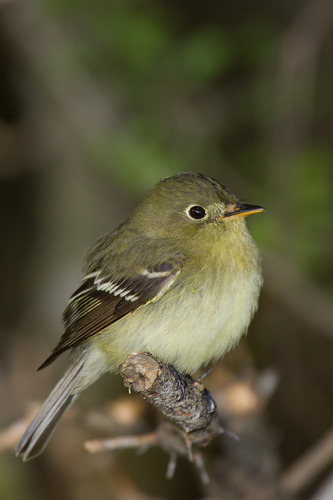
Acadian Flycatcher
The Acadian Flycatcher (*Empidonax virescens*) is a small, Neotropical migratory bird of the tyrant flycatcher family. It is known for its distinctive "peet-sah" song and preference for mature, deciduous forests with a well-developed understory and proximity to water. This species plays a crucial role in controlling insect populations within its forest habitat. While not globally threatened, it is considered a species of concern in some regions due to habitat loss and fragmentation. The Acadian Flycatcher is not particularly prominent in human culture, but its presence is a good indicator of healthy, mature forest ecosystems.
13-15 cm
Length
22-25 cm
Wingspan
Least Concern
Conservation Status
Distribution
The Acadian Flycatcher breeds across the eastern United States, ranging from southern New England and New York west to southern Minnesota and eastern Texas, and south to northern Florida. It winters in Central America and northern South America, primarily in countries like Nicaragua, Costa Rica, Panama, Colombia, and Venezuela. Migratory routes typically follow the Gulf Coast and across the Gulf of Mexico.
Lifespan
The average lifespan in the wild is not well-documented, but individuals have been known to live at least 8 years.
Acadian Flycatcher's Habitat
Habitat Types
Mature deciduous forests, Bottomland hardwood forests, Forested wetlands, Riparian corridors
Climate Zones
Temperate, Subtropical
Adaptations
The Acadian Flycatcher's preference for forests with dense understories and proximity to water provides ample foraging opportunities and protection from predators. Their relatively long wings facilitate efficient long-distance migration.
Variations
No recognized subspecies exist, although slight variations in plumage and vocalizations may occur across the breeding range. These variations are not considered significant enough to warrant subspecies classification.
Appearance
Breeding Plumage
Plumage remains relatively consistent throughout the year. Adults have olive-green upperparts, whitish underparts with a slight yellowish wash on the belly, and two white wing bars. The throat is white, and there is a faint white eye-ring.
Seasonal Feather Changes
Minimal seasonal variation.
Sex Based Plumage Differences
Males and females are visually similar.
Notable Features
White eye-ring, Two white wing bars, Slightly peaked crown, Relatively long, flat bill
Diet and Feeding
Primary Foods
Insects, Spiders, Small invertebrates
Foraging Behavior
Acadian Flycatchers primarily employ a sit-and-wait foraging strategy. They perch on a branch, often in the mid-story of the forest, and sally out to catch flying insects in mid-air. They also glean insects and spiders from foliage.
Specializations
Their relatively long, flat bill is well-suited for capturing flying insects. They have excellent aerial agility, allowing them to maneuver quickly and capture prey.
Seasonal Diet Variations
Diet is primarily insectivorous throughout the year. During the breeding season, they may consume a higher proportion of larger insects to feed their young. On the wintering grounds, they may supplement their diet with small fruits when insect availability is low.
Behavior
Social Structure
Acadian Flycatchers are generally solitary or found in pairs during the breeding season. They are territorial during breeding, defending their nesting area from other flycatchers.
Communication
Distinctive "peet-sah" song, Various call notes, including a sharp "peet" and a soft "whit", Wing-fluttering and tail-fanning during courtship and territorial displays
Migration
Acadian Flycatchers are Neotropical migrants, undertaking long-distance migrations between their breeding grounds in North America and their wintering grounds in Central and South America. Migration is typically nocturnal.
Territorial or Group Behaviors
Males are highly territorial during the breeding season, defending their territory against intruders. Outside of the breeding season, they are generally solitary.
Conservation
Threats
Habitat loss and fragmentation (especially loss of mature forests), Forest degradation due to unsustainable logging practices, Pesticide use (reducing insect prey), Climate change (potential shifts in habitat suitability)
Protection Programs
Conservation of mature forests through protected areas and sustainable forestry practices, Monitoring programs to track population trends
Local National Laws
Protected under the Migratory Bird Treaty Act in the United States.
Population Trend
Stable
Population Estimates
The global population is estimated to be around 9.8 million individuals.
Interesting Facts
They are known for their 'explosive' song.
The characteristic 'peet-sah' song is delivered with a forceful expulsion of air, making it sound louder than expected for such a small bird.
They often reuse the same nesting territory year after year.
This site fidelity suggests the importance of specific habitat characteristics for successful breeding.
They can hover like a hummingbird
This flight adaptation is used during feeding.
Faqs about Acadian Flycatcher
What is the best way to identify an Acadian Flycatcher?
Look for a small, olive-green flycatcher with a white eye-ring, two white wing bars, and a yellowish wash on the belly. Listen for its distinctive "peet-sah" song.
Where can I find Acadian Flycatchers?
Look for them in mature deciduous forests, especially those with a well-developed understory and proximity to water, during the breeding season (May-August).
Are Acadian Flycatchers endangered?
No, they are currently listed as a species of Least Concern by the IUCN. However, they are facing threats from habitat loss and degradation, so conservation efforts are important.
Copyright @ Nature Style Limited. All Rights Reserved.
 English
English